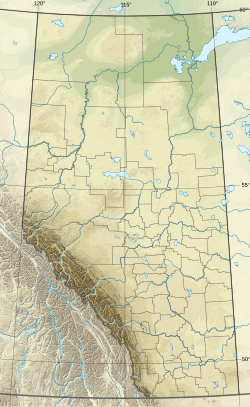Schuler, Alberta
Schuler | |
|---|---|
| Coordinates: 50°19′53″N 110°06′27″W / 50.33139°N 110.10750°W | |
| Country | Canada |
| Province | Alberta |
| Region | Southern Alberta |
| Census division | 1 |
| Municipal district | Cypress County |
| Government | |
| • Type | Unincorporated |
| • Governing body | Cypress County Council |
| Area (2021)[1] | |
| • Land | 0.6 km2 (0.2 sq mi) |
| Population (2021)[1] | |
• Total | 86 |
| • Density | 142.8/km2 (370/sq mi) |
| Time zone | UTC−07:00 (MST) |
| • Summer (DST) | UTC−06:00 (MDT) |
| Area code(s) | 403, 587, 825 |
Schuler is a hamlet in southern Alberta, Canada within Cypress County,[2] located 4 kilometres (2.5 mi) east of Highway 41, approximately 40 kilometres (25 mi) northeast of Medicine Hat.
History
The settlement was named after Norman Banks Schuler, who settled a homestead in the area in the spring of 1910. In the fall of that year he was given the Post Office for the district. The hamlet itself acts as a service centre for people on the surrounding farms. Grain elevators were built by the Alberta Wheat Pool in 1924 and 1928 and by the Pioneer Grain Company in 1928. In July 1997, the last train hauled grain from the two remaining elevators. It is home to an ECS to Grade 9 school.
Demographics
| Year | Pop. | ±% |
|---|---|---|
| 1941 | 113 | — |
| 1951 | 131 | +15.9% |
| 1956 | 157 | +19.8% |
| 1961 | 156 | −0.6% |
| 1966 | 116 | −25.6% |
| 1971 | 97 | −16.4% |
| 1976 | 121 | +24.7% |
| 1981 | 105 | −13.2% |
| 1986 | 97 | −7.6% |
| 1991 | 88 | −9.3% |
| 1991A | 92 | +4.5% |
| 1996 | 104 | +13.0% |
| 2001 | 89 | −14.4% |
| 2006 | 81 | −9.0% |
| 2011 | 63 | −22.2% |
| 2016 | 72 | +14.3% |
| 2021 | 86 | +19.4% |
| Source: Statistics Canada [3][4][5][6][7][8][9][10][11][12][13][14][15][16][1] | ||
In the 2021 Census of Population conducted by Statistics Canada, Schuler had a population of 86 living in 38 of its 42 total private dwellings, a change of 19.4% from its 2016 population of 72. With a land area of 0.6 km2 (0.23 sq mi), it had a population density of 143.3/km2 (371.2/sq mi) in 2021.[1]
As a designated place in the 2016 Census of Population conducted by Statistics Canada, Schuler had a population of 72 living in 35 of its 39 total private dwellings, a change of 14.3% from its 2011 population of 63. With a land area of 0.6 km2 (0.23 sq mi), it had a population density of 120.0/km2 (310.8/sq mi) in 2016.[16]
See also
References
- ^ a b c d "Population and dwelling counts: Canada and designated places". Statistics Canada. February 9, 2022. Retrieved February 10, 2022.
- ^ "Specialized and Rural Municipalities and Their Communities" (PDF). Alberta Municipal Affairs. June 3, 2024. Retrieved June 14, 2024.
- ^ Ninth Census of Canada, 1951 (PDF). Vol. SP-7 (Population: Unincorporated villages and hamlets). Dominion Bureau of Statistics. March 31, 1954. Retrieved September 22, 2024.
- ^ Census of Canada, 1956 (PDF). Vol. Population of unincorporated villages and settlements. Dominion Bureau of Statistics. October 25, 1957. Retrieved September 23, 2024.
- ^ 1961 Census of Canada: Population (PDF). Series SP: Unincorporated Villages. Vol. Bulletin SP—4. Ottawa: Dominion Bureau of Statistics. April 18, 1963. Retrieved September 25, 2024.
- ^ Census of Canada 1966: Population (PDF). Special Bulletin: Unincorporated Places. Vol. Bulletin S–3. Ottawa: Dominion Bureau of Statistics. 1968. Retrieved September 25, 2024.
- ^ 1971 Census of Canada: Population (PDF). Special Bulletin: Unincorporated Settlements. Vol. Bulletin SP—1. Ottawa: Statistics Canada. 1973. Retrieved September 25, 2024.
- ^ "Geographical Identification and Population for Unincorporated Places of 25 persons and over, 1971 and 1976". 1976 Census of Canada (PDF). Supplementary Bulletins: Geographic and Demographic (Population of Unincorporated Places—Canada). Vol. Bulletin 8SG.1. Ottawa: Statistics Canada. 1978. Retrieved September 26, 2024.
- ^ 1981 Census of Canada (PDF). Place name reference list. Vol. Western provinces and the Territories. Ottawa: Statistics Canada. 1983. Retrieved September 26, 2024.
- ^ 1986 Census of Canada (PDF). Population. Vol. Unincorporated Places. Ottawa: Statistics Canada. 1988. Retrieved September 26, 2024.
- ^ 91 Census (PDF). Population and Dwelling Counts. Vol. Unincorporated Places. Ottawa: Statistics Canada. 1993. Retrieved September 26, 2024.
- ^ 96 Census (PDF). A National Overivew: Population and Dwelling Counts. Ottawa: Statistics Canada. 1997. Retrieved September 26, 2024.
- ^ "Population and Dwelling Counts, for Canada, Provinces and Territories, and Census Divisions, 2001 and 1996 Censuses - 100% Data (Alberta)". Statistics Canada. August 15, 2012. Retrieved September 19, 2024.
- ^ "Population and dwelling counts, for Canada, provinces and territories, and designated places, 2006 and 2001 censuses - 100% data (Alberta)". Statistics Canada. July 20, 2021. Retrieved September 19, 2024.
- ^ "Population and dwelling counts, for Canada, provinces and territories, and designated places, 2011 and 2006 censuses (Alberta)". Statistics Canada. February 8, 2012. Retrieved September 19, 2024.
- ^ a b "Population and dwelling counts, for Canada, provinces and territories, and designated places, 2016 and 2011 censuses – 100% data (Alberta)". Statistics Canada. February 8, 2017. Retrieved February 13, 2017.


